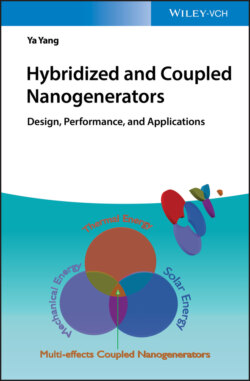Читать книгу Hybridized and Coupled Nanogenerators - Ya Yang - Страница 33
2.3.2.2 Metal
ОглавлениеMetallic materials, such as copper (Cu) foils, aluminum (Al) foils, and silver (Ag) foils, have been widely used as electrodes of TENGs, which can export the charges generated by the coupling of triboelectric friction and electrostatic induction. Al foils can be used as both a triboelectric layer and an electrode in the TENG due to the high electrical conductivity and the positive position on the triboelectric series. The surface of the Al foil would form positive charges, when it makes contact with the other film with the negative position. Superhydrophobic surfaces emerging from the cooperation of low surface energy and micro/nanostructures are widely explored in biological systems. To increase the surface roughness and environmental stability of the metallic electrodes, Zhao et al. fabricated a superhydrophobic surface on the Al substrates by using chemical etching method [61]. Al substrates were firstly polished to eliminate the dense oxidation on the Al substrates. The polished surface is smooth, as shown in Figure 2.7a,b. The contact angle on the surface is about 62°, as illustrated in Figure 2.7c. After chemical etching, nanostructures are fabricated on the Al substrates, as shown in Figure 2.7d. High magnification SEM of the etched Al substrate shows that protruding structures were formed on the substrate (Figure 2.7e). The contact angle on the etched Al substrate is about 33°, due to the cooperation of the hydrophilic property of Al and the nanostructures.
By modifying with 1H,1H,2H,2H‐perfluorodecyltrichlorosilane/toluene solution, the surface energy of the etched Al substrate could be decreased, leading to the formation of a superhydrophobic surface on the Al substrate. Figure 2.7i shows that the contact angle on the prepared superhydrophobic surface is about 153°. Figure 2.7j shows the values for three different surfaces. Figure 2.7k shows a photograph of water drops with different sizes on the superhydrophobic surface. It is found that the superhydrophobic surface could form positive charges when it made contact with a polyamide film in the TENG.
